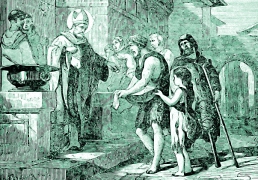Lives of the Saints
Our Models and Protectors
Spiritual Bouquet:
March 1st

Saint Albinus
Bishop
(470-550)
Saint Albinus was of an ancient and noble family in Brittany, and from his childhood was fervent in every exercise of piety. He ardently sighed after the happiness which a devout soul finds in being disengaged from all earthly things. Having embraced the monastic state, despite his parents' disapproval, he shone a perfect model of virtue, taking upon himself all the humblest offices and disciplining his flesh by every kind of mortification. In brief, he lived as if in all things he were without any will of his own; and his soul seemed so perfectly governed by the spirit of Christ as to live only for Him.
In 504, at the age of thirty-five Saint Albinus was chosen Abbot of his monastery; Saint Fortunatus, his first historian, compared the monastery at that time to a garden rendered beautiful by the most exquisite, most varied, most fragrant flowers. Twenty-five years later, divine Providence gave the Abbot to the entire region as Bishop of Angers. A day did not pass without his instructing his people, for he believed that the soul needs daily nourishment just as imperatively as does the flesh.
Many Christians of his diocese had fallen into slavery through the invasions of the barbarians, and Saint Albinus used every resource available to him for their redemption. To the graces of charity from which his people benefitted, were joined those deriving from his public miracles. He resurrected a young child; and when one of his servants died during his absence, those who carried the man to his grave were unable to lower him until the bishop arrived to give the final benediction. He established and restored measures of ecclesiastical discipline, through the third Council of Orleans, convened through his influence over King Childebert, son of Clovis, who greatly respected his opinions. In brief, he was inflamed with a holy zeal for the glory of God in all aspects of life. Honored by all, he was never affected with vanity.
Saint Albinus died after making a long journey which he undertook to consult Saint Cesarius, Bishop of Arles, concerning matters of episcopal government. He had been the benediction of his diocese for twenty-one years; he died on March 1, 549. He is often represented preaching in the episcopal pulpit or curing the sick, or holding chains while commanding prison doors to be opened.
Little Pictorial Lives of the Saints, a compilation based on Butler's Lives of the Saints and other sources by John Gilmary Shea (Benziger Brothers: New York, 1894)